Selective breeding proved to be the most effective process for genetic improvement of plants and animals. Achievements in increased yields of paddy, wheat, milk, meat etc. during recent decades are due in large to selection. In aquaculture, the potential has not been fully exploited through selection. However, the selection work on Atlantic salmon in Norway, the Channel catfish in the USA and the Nile tilapia in the Philippines is enough testimony to advocate that it is quite possible to improve many economic traits like, survival, growth, resistance to disease, meat quality etc. through selection. In fact, many hatchery breeding programs result in lower quality fish through inbreeding depression.
In most of the developing countries, particularly in India and other South-east Asian countries, a substantial number of people depend on fishing or fish culture for their living. Consequently, there is over-exploitation due to heavy fishing both in marine and riverine areas reducing the size of populations in the absence of proper replenishment of the depleted stocks.
In aquaculture ever since the success of induced breeding of the Indian major carps through hypophyzation, the technique has been gradually popularized throughout the Indian subcontinent as well as neighbouring countries such as Pakistan, Bangladesh, Burma, Nepal etc. Consequently, many hatcheries have developed in almost all these countries. However, in over four decades, attention has been paid only to produce fish seed to meet a pre-targeted quantity with very little regard to quality (Eknath 1991).
A survey of carp hatcheries in the state of Karnatak in South India was made (Eknath and Doyle 1990) because of the growing concern that hatchery stocks may be inbred, as suggested by rapid deterioration of their performance. Eknath and Doyle (1990) found that the rate of the accumulation of inbreeding (F) was particularly high for the three most desirable carp species in the country, catla, rohu and mrigal. The most important reasons for this appeared to be that all the hatcheries function as isolated genetically closed units, raising their own stocks of brood fish. Moreover, the individuals for replenishment of brood stock in the hatchery are those which were retained after the hatchery had reached its seed production target for a given year (Eknath and Doyle 1990). It was also reported that small hatcheries appear to rapidly inbreed their stocks. The tendency to breed slow growing and later maturing individuals was also observed in some of the hatcheries (Eknath and Doyle, 1985), which is undersirable.
The survey Basavaraju et al. (1997) conducted particularly for catla in the three major seed producing hatcheries in the state of Karnataka, namely Tunga Bhadra Dam (TBD), Bhadra Reservoir Project (BRP) and Kabiri Reservoir Project (KRP), also indicated that the practices followed by these hatcheries are likely to result in both inbreeding and negative selection.
Maheshwari and Biradar (1998) reported decline in fertility of hatchery bred Labeo rohita due to inbreeding. A study was conducted at Powarkheda, Freshwater Fish Farm of the Central Institute of Fisheries Education (ICAR), India where induced breeding of L. rohita was carried out between 1982 and 1992 to assess fertility. It has been reported that breeding of related individuals up to the sixth generation led to 71% decline in fertility level as compared to base population. It was also observed that the range, standard deviation and coefficient of variation were highest for fecundity in the first generation. This indicates, according to the authors, the scope for improvement through selection.
Currently two projects are in operation on carp selection. One on Labeo rohita as already mentioned, the other on Catla catla at the University of Agricultural Sciences, Bangalore, Karnataka State.
Founder populations of L. rohita have been collected from five different rivers in North India, namely, Rivers Ganga, Gomati, Yamuna, Sutlej and Brahmaputra, which are the native habitat of rohu. Rohu stock from the fish farm of CIFA has also been added to the gene pool. Thus the base population for the selection project consisted of rohu, from six sources, to broaden the gene pool. Different stocks of rohu are shown in Plate 11.
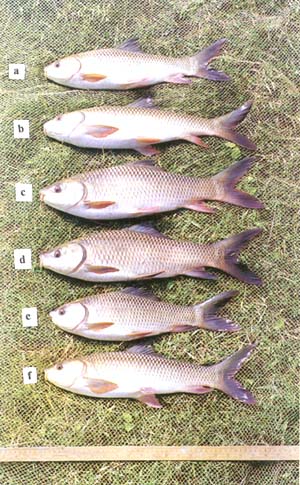
Plate 11. Rohu (L. rohita) from different source
| a. River Ganga | b. River Gomati |
| c. River Yamuna | d. River Sutlej |
| e. River Brahmaputra | f. Local (Farm) rohu |
All these stocks were collected from fry to fingerling stages and reared separately in earthen ponds for a period of one to two months before they were physically marked and stocked in communal ponds for raising to brood fish.
Marking was done using dye, fin clipping and a combination of both. Ganga rohu were dye injected with M-procian blue at the base of the right pectoral fin and Yamuna rohu at the base of the left pectoral fin. In the case of Gomati and farm rohu the right and left pelvic fins were clipped respectively, while the Sutlej rohu were marked with the blue dye, inject at the base of the left pectoral fin by clipping the right pelvic fin. The reverse has been done to mark the Brahmaputra rohu, i.e. by injecting blue at the base of the right pectoral and clipping the left pelvic fin (Gupta, 1994). During 1993, the first groups of full sibs were produced from the local and Ganga stocks as these two stocks were matured. Two or three males were mated with one female (paternal half sibs). However, during the year 1994, full-sib groups (families) were produced from all the six stocks of rohu: two or three females were mated to a male, producing maternal half-sibs. (Reddy et al., 1998). Marking of rohu stocks has been shown in Figure 9.
Rearing full-sib groups to tagable size fingerlings has been done in earthen nursery ponds of 100 m2 for four to five months (Saha et al., 1997). After the full-sib attained suitable tagging size (8–10 g) the fish were tagged by using Passive Integrated Transponder (PIT) tags, before they are stocked in ponds for communal rearing under both mono and polyculture systems. (Mahapatra et al., 1998). PIT tags are shown in Plate 12.

Plate 12. Passive integrated transponder (PIT) tags, tag implanter and tag reader
After a period of one year, data pertaining to growth (length and weight) was collected and analysed to evaluate the individual breeding value and to rank the fish. The data so far collected indicated that growth and survival of the wild rohu stocks were equal to or better than the farmed stock. This indicated that the present procedures followed by hatcheries for seed production are improper. A substantial additive genetic variation has been observed for growth rate and survival of rohu, both under mono and polyculture systems, thus indicating that growth rate and survival of rohu can be improved through selective breeding. Competition for food may prohibit rohu from exhibiting its growth potential in polyculture. Proper feeding and pond management is essential while testing fish in a breeding programme.
The study so far has also indicated that stocks and full-sib groups within stocks ranked consistently high for growth performance in mono and polyculture, which suggests that there is no need for the development of special rohu lines for different systems. However, further studies are envisaged to test genotype by environment interaction, i.e. under intensive/extensive production systems and in different climatic zones (CIFA and AKVAFORSK, 1996).
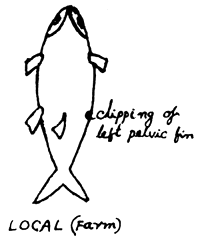 | 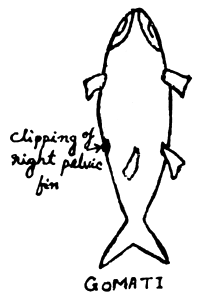 |
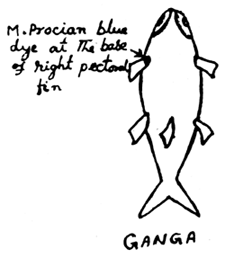 | 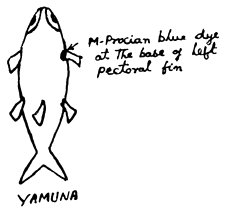 |
 |  |
Figure 9. Illustration of marking rohu from different sources, with dye and fin clipping
The main objectives of this project are to determine the extent of the problem of inbreeding in domesticated stocks of Catla catla in Karnataka state and to design a breeding programme for the improvement of the cultured catla stocks. To this extent the methodologies being used are survey and data collection from state hatcheries for the assessment of the genetic status of the catla stocks presently being used for seed production and culture.
The hypothesis of whether the domesticated stocks are inbred due to poor broodstock management will be tested by comparing the level of genetic variation between these and wild stock of catla obtained from rivers, Ganga, Brahmaputra and Mahanadi and by allozyme, mitochondrial DNA (RAPD) and tetranucleotide microsatillite electrophoretic techniques.
Protocols are planned for improving the genetic management of domesticated carp stocks in the state and to disseminate through on-station and on-farm comparative performance testing and by the use of best strains for selective breeding to further enhance their commercial importance (Basavaraju et al., 1997).
Progress to date
A survey of the three main catla producing hatcheries of the state, TBD, BRP and KRP have indicated that the common practices of brood stock replacement seems to be to retain a few fingerlings each year which are normally collected towards the end of the spawning season, consisting of not more than two or three families. These practices are likely to result in inbreeding and selection for poor growth (Basavaraju et al., 1997). Genetic analysis of the hatchery stocks using four tetranucleotide microsatellite loci has shown these stocks to be different from each other. Results of growth trials indicated no significant differences in the performance between the stocks of the key hatcheries. However, the interhatchery crosses produced highly significant increases in yield (Basavaraju et al., 1977), as described below.
The rate of in breeding in smaller hatcheries was found to be unacceptably high which may have brought about a reduction in the culture performance of the hatchery bred seed.
Basavaraju et al. (1997) also reported the performance of intra and inter strain crosses between individuals of the same hatcheries viz. TBD, BRP and KRP and between two different hatcheries mentioned above. These studies have shown that crosses between the individuals of the same hatchery did not show any clear differences in growth performance suggesting that no one strain would necessarily be recommended over another.
On the other hand, inter hatchery crosses between the strains at TBD and BRP and the reciprocal cross when stocked under polyculture along with rohu and mrigal at BRP and in two commercial farm ponds and under monoculture in a pond at the Fisheries Research Station (Hassarghatta) have shown an apparent enhancement of culture performance in the crossbred fish over the pure intrahatchery crosses. There was considerable increase (P<0.001) in yield of the interhatchery crosses compared to intrahatchery crosses ranging from 120–245%, indicating positive heterosis for growth in the interhatchery stocks.
Thus, to summarize the findings of Eknath and Doyle (1990) and Basavaraju et al. (1997), it is evident that the hatchery practices indicated inbreeding depression and negative selection for growth in domesticated stocks of Indian major carps.